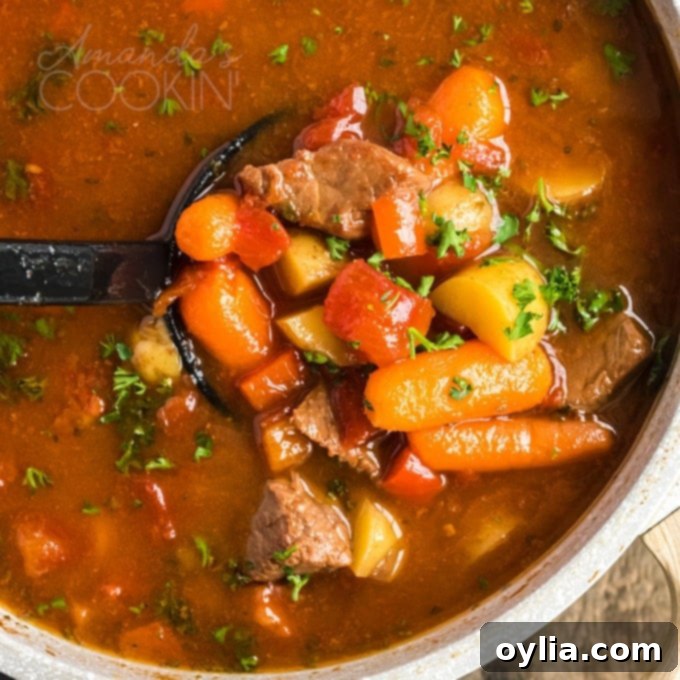The Ultimate Homemade Dutch Oven Goulash Recipe: A Hearty Comfort Food
There’s nothing quite like a warm, comforting bowl of goulash, and this homemade Dutch oven recipe truly hits the spot any time of the year. Whether it’s a chilly autumn evening, a frosty winter day, or even a rainy spring afternoon, this hearty beef and vegetable stew offers a comforting embrace. It’s a remarkably easy recipe, featuring tender chuck roast slow-cooked to perfection, making it an ideal choice for busy weeknights or a satisfying family dinner. Imagine coming home to this rich aroma after a long day, or serving it up while watching the kids’ football games in the crisp air. For those who prefer the set-it-and-forget-it convenience, we also have a fantastic Slow Cooker Hungarian Goulash version.
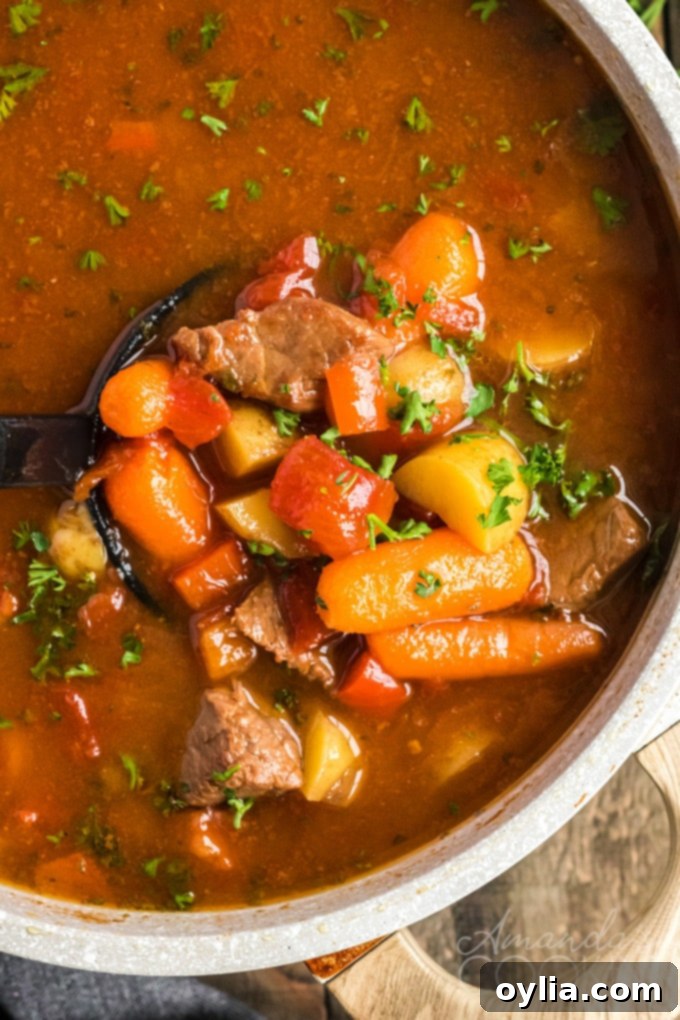
Classic Homemade Goulash: A Timeless Family Favorite
This goulash recipe is more than just a meal; it’s a culinary hug in a bowl, perfect for bringing the family together. While stews are undeniably embraced during the colder months, the rich, savory flavors and hearty ingredients make this goulash a welcome sight at any dinner table, all year round. Our recipe features succulent chunks of protein-packed beef chuck roast, slow-simmered in a luxurious, paprika-infused broth, alongside classic root vegetables like potatoes and carrots, and bright sweet peppers.
Why This Dutch Oven Goulash Will Become Your Go-To Recipe
- Unmatched Comfort: Few dishes provide the same level of warmth and satisfaction as a slow-cooked goulash. It’s the quintessential comfort food, ideal for nourishing body and soul.
- Incredibly Flavorful: The combination of sweet paprika, caraway seeds, marjoram, fire-roasted tomatoes, and Worcestershire sauce creates a depth of flavor that is truly irresistible. Browning the beef first adds another layer of rich, savory notes.
- Tender Perfection: Using beef chuck roast means that after hours of simmering in a Dutch oven, the meat becomes incredibly tender, practically melting in your mouth.
- Easy to Prepare: Despite its impressive flavor, this goulash is surprisingly simple to make. The hands-on time is minimal, allowing the Dutch oven to do most of the work.
- Family-Friendly Meal: Packed with vegetables and hearty beef, this is a complete meal that appeals to all ages. It’s a wonderful way to get nutritious ingredients into everyone’s diet.
- Excellent for Meal Prep: Like many stews, goulash often tastes even better the next day as the flavors have more time to meld and deepen. It reheats beautifully, making it perfect for leftovers.

Ingredients You Will Need for This Hearty Goulash
- 2 pounds beef chuck roast, cut into 1-inch cubes (or stew meat)
- 1/4 cup sweet paprika
- 1 teaspoon caraway seeds
- 2 teaspoons dried marjoram
- 2 teaspoon Kosher salt
- 1/2 teaspoon freshly ground black pepper
- 1 heaping tablespoon all purpose flour
- 3 tablespoons olive oil
- 1 large yellow onion, chopped
- 1 teaspoon minced garlic (about two cloves)
- 1 14-ounce can fire roasted diced tomatoes, undrained
- 5 cups beef broth
- 2 tablespoons Worcestershire sauce
- 1 1/2 cups baby carrots
- 3 cups quartered baby Yukon Gold potatoes
- 1 cup chopped sweet peppers
Ingredient Notes and Smart Substitutions
To ensure your homemade goulash is nothing short of spectacular, let’s dive a little deeper into the ingredients and potential substitutions:
- Beef Chuck Roast: This cut is ideal for stewing. Its marbling and connective tissue break down beautifully during slow cooking, resulting in incredibly tender and flavorful beef. If chuck roast isn’t available, you can use pre-cut stew meat or other tough cuts like beef round or brisket, which also benefit from long, moist heat cooking.
- Sweet Paprika: This is the star spice of goulash, providing its characteristic color and mild, sweet pepper flavor. While Hungarian sweet paprika is traditional and highly recommended for its quality, any good quality sweet paprika will work. Avoid using hot paprika unless you specifically desire a spicy goulash. Smoked paprika can add an interesting depth, but use it sparingly as it can overpower.
- Caraway Seeds: These small seeds add a distinct, slightly anise-like warmth and complexity that is classic in many Eastern European dishes. They are highly recommended for an authentic flavor. If you’re not a fan or can’t find them, you can omit them, though the flavor profile will be slightly different.
- Dried Marjoram: A close cousin to oregano, marjoram has a milder, sweeter, and more delicate flavor. It complements the beef and paprika beautifully. If fresh marjoram is all you have, use about 3 teaspoons, adding it towards the end of cooking for best flavor.
- Kosher Salt and Freshly Ground Black Pepper: Essential seasonings. Adjust to your taste preference as you cook, especially after adding the broth. Remember that different broths can vary in sodium content.
- All-Purpose Flour: Used to coat the beef, it helps create a crust during browning and acts as a thickening agent for the stew, forming a rich gravy. For a gluten-free option, you can omit the flour and thicken the stew at the end with a cornstarch slurry (1 tablespoon cornstarch mixed with 2 tablespoons cold water) stirred in during the last 15-20 minutes of simmering.
- Fire Roasted Diced Tomatoes: These add a wonderful smoky depth and acidity to the stew, which balances the richness of the beef. If you can’t find fire-roasted, regular diced tomatoes are a fine substitute, though you might miss that subtle smoky note.
- Beef Broth: Opt for a good quality beef broth or stock. Low-sodium broth gives you more control over the salt content of your goulash.
- Worcestershire Sauce: A secret weapon for adding umami and a savory tang, enhancing the overall depth of flavor without being overtly noticeable.
- Baby Carrots and Baby Yukon Gold Potatoes: These root vegetables are perfect for goulash. Baby carrots are naturally sweet and tender, while baby Yukon Golds hold their shape well and have a creamy texture. You can substitute with regular carrots (cut into 1-inch pieces) and other waxy potato varieties like red potatoes or new potatoes, also cut into bite-sized pieces. Avoid starchy potatoes like Russets, as they tend to break down too much.
- Chopped Sweet Peppers: Adding these towards the end preserves their vibrant color and slightly crisp texture, adding a fresh contrast to the long-simmered stew. Bell peppers of any color (red, yellow, orange) work wonderfully.
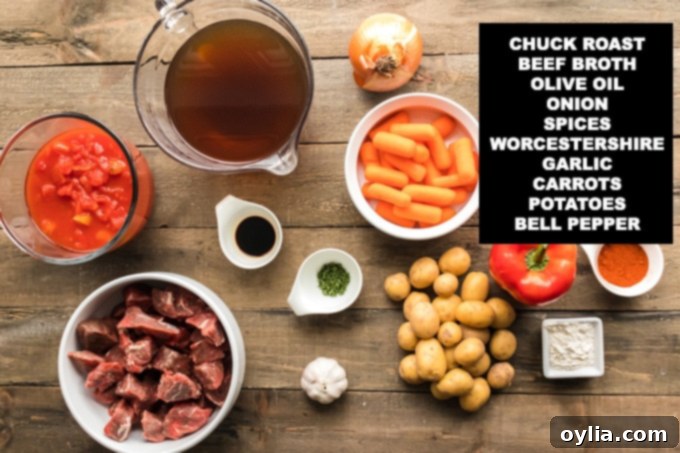
Helpful Kitchen Tools for Your Goulash Journey
Having the right tools can make all the difference in your cooking experience:
- Dutch oven: An essential for this recipe! Its heavy construction and even heat distribution are perfect for slow simmering stews, ensuring your goulash cooks uniformly and develops deep flavors. A 5-quart capacity is generally ideal for this recipe.
- Ladle: For easy and mess-free serving of your delicious goulash.
- Wooden spoon: Ideal for stirring and scraping the bottom of the Dutch oven without damaging the surface.
- Serving bowls: Because a beautiful dish deserves a beautiful presentation!
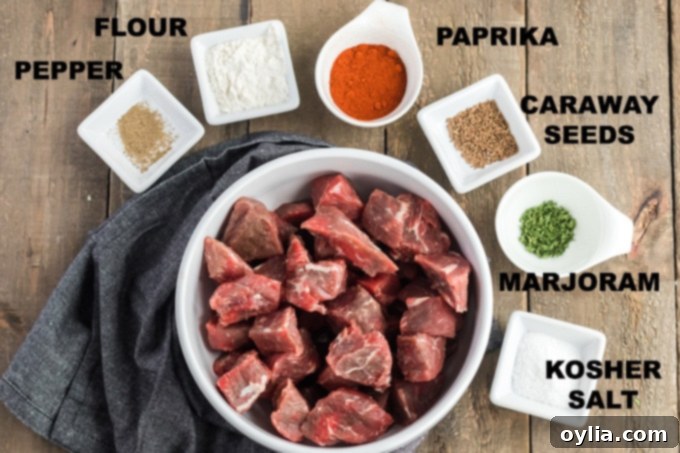
How to Make Dutch Oven Goulash: Step-by-Step Instructions
- Prepare the Beef: In a large plastic zipper bag, combine the paprika, caraway seeds, marjoram, Kosher salt, black pepper, and flour. Add the cubed beef chuck roast to the bag, seal it securely, and shake vigorously until all the meat is evenly coated with the spice mixture. This step not only seasons the meat but also helps to thicken the stew later.
- Sauté Aromatics: Heat the olive oil in your Dutch oven over medium heat. Add the chopped yellow onion and sauté for about 3-4 minutes, or until it softens and becomes translucent. Then, add the minced garlic and continue to sauté for another 30 seconds until fragrant. Be careful not to burn the garlic, as it can turn bitter.
- Sear the Beef: Pour the entire contents of the zipper bag (beef and any remaining spice mixture) into the Dutch oven with the onions and garlic. Cook, turning the beef occasionally, until all sides are nicely browned. This searing step is crucial for developing deep, rich flavors through the Maillard reaction. If your Dutch oven is small, you might need to brown the beef in batches to avoid overcrowding, which can steam the meat instead of searing it.
- Simmer the Base: Pour in the beef broth, Worcestershire sauce, and the entire can of fire-roasted diced tomatoes (including their juices). Stir well to combine, making sure to scrape up any browned bits from the bottom of the pot – these bits are packed with flavor! Bring the mixture to a boil, then reduce the heat to low, cover the Dutch oven, and let it simmer gently for one hour. This initial simmering time allows the beef to begin tenderizing and the flavors to meld.
- Add Root Vegetables: Carefully add the baby carrots and quartered baby Yukon Gold potatoes to the Dutch oven. Stir them into the liquid, ensuring they are mostly submerged. Cover the pot again and continue to cook on low heat for another hour, or until the carrots and potatoes are tender.
- Finish with Sweet Peppers: Finally, add the chopped sweet peppers. Stir them in, cover, and cook for an additional 30 minutes, or until both the meat and all the vegetables are fork-tender. This later addition of sweet peppers keeps them from becoming overly soft, maintaining a pleasant texture and vibrant color in your goulash.
Tips for the Best Homemade Goulash
- Don’t Rush the Searing: Browning the beef properly creates a depth of flavor that can’t be replicated. Ensure your Dutch oven is hot and don’t overcrowd the pot.
- Deglaze for Flavor: After browning the beef, use the liquid ingredients (broth, tomatoes) to scrape up any flavorful browned bits stuck to the bottom of the pot. This is called deglazing and it adds immense flavor.
- Taste and Adjust: Always taste your goulash as it simmers, especially before serving. Adjust salt, pepper, or even a pinch more paprika if needed.
- Let it Rest: While not strictly necessary for goulash, letting it sit for 10-15 minutes off the heat before serving can allow the flavors to deepen further.
- Make Ahead: Goulash is one of those dishes that tastes even better the next day. The flavors continue to meld and develop, making it an excellent option for meal prepping or entertaining.
Serve This Goulash with One of These Delicious Ideas
This rich and hearty goulash pairs perfectly with something to soak up all that incredible sauce. Here are some of our favorite accompaniments:
- Classic Italian Bread
- Fluffy Homemade Biscuits
- Savory Herb Buttermilk Biscuits
- Sweet Homemade Hawaiian Rolls
- Unique Bretzel Rolls (Pretzel Sandwich Rolls)
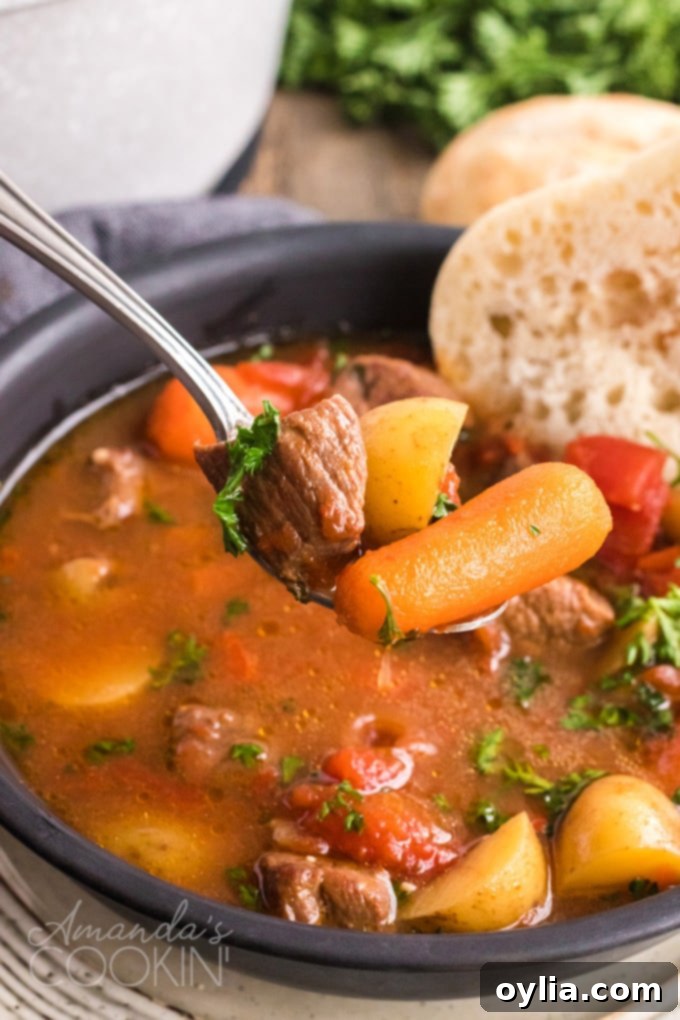
Frequently Asked Questions About Goulash
- Can I make this goulash in a slow cooker? Absolutely! While this recipe is for a Dutch oven, goulash is a fantastic slow cooker meal. You can adapt the searing steps to a skillet first, then transfer everything to your slow cooker. For a dedicated slow cooker recipe, check out our Slow Cooker Hungarian Goulash with Noodles.
- How do I store leftover goulash? Once cooled, transfer any leftover goulash to an airtight container and refrigerate for up to 3-4 days.
- Can goulash be frozen? Yes, goulash freezes beautifully! Allow it to cool completely, then transfer to freezer-safe containers or heavy-duty freezer bags. It can be stored in the freezer for up to 3 months. Thaw overnight in the refrigerator before reheating gently on the stovetop or in the microwave.
- What’s the difference between Hungarian and American Goulash? Traditional Hungarian goulash is a rich, paprika-heavy beef soup or stew, typically served with potatoes or dumplings. American goulash, often called “chop suey” or “slumgullion,” is usually a simpler, pasta-based dish made with ground beef, elbow macaroni, tomato sauce, and sometimes cheese. This recipe leans more towards the hearty, traditional Hungarian-style stew.
- How can I thicken my goulash if it’s too thin? If you find your goulash isn’t thick enough, you can create a simple cornstarch slurry. Mix 1 tablespoon of cornstarch with 2 tablespoons of cold water until smooth. Stir this into the simmering goulash and cook for a few more minutes until it thickens to your desired consistency.
Facts About Goulash: A Culinary Journey Through History
Goulash is a dish surrounded by rich history and diverse interpretations. Let’s explore some fascinating facts:
- A Paprika-Laden Meat Stew: At its core, goulash is a meat-based soup or stew that features vegetables and is generously seasoned with paprika. This defining spice gives goulash its signature color and unique flavor profile.
- Hungarian Origins: While commonly known as Hungarian Goulash, its roots trace back to medieval Hungary. The word “gulyás” originally referred to herdsmen (gulyás in Hungarian), and the dish itself was a simple, hearty meal prepared by these cattle herders on the Hungarian plains.
- Widespread Popularity: From its humble Hungarian beginnings, goulash has spread across Central and Southern Europe, and, of course, found a beloved place in kitchens across the United States. Each region, and often each family, has adapted the basic concept to suit local tastes and available ingredients.
- Generational Recipes: It’s common for many modern-day families to possess a cherished goulash recipe that has been lovingly passed down through generations. These recipes often carry unique family twists and secret ingredients, making each rendition special.
- Myriad Forms and Variations: Over time, goulash has evolved into many different forms. Beyond the classic beef and potato version, you’ll find variations cooked with different meats like pork or turkey, a wider array of vegetables, and served with a variety of accompaniments. Some popular variations include goulash with egg noodles, creamy versions, or those served with soft dumplings.
- Versatile Cooking Methods: Goulash can be prepared using various cooking methods to achieve tender results. It’s excellent cooked slowly on the stovetop, baked in the oven in a Dutch oven (as in this recipe), or conveniently prepared in a slow cooker, allowing for flexibility in modern kitchens.
- Ancient Preservation Techniques: Did you know that back in the 9th century, Hungarian shepherds would cook and flavor meat, then dry it out under the sun? This preserved meat was then packed into bags made from sheep’s stomach. When it was time for a meal, the shepherds would simply add water to the dried mixture, creating a quick and nourishing stew while tending their flocks. Thankfully, we no longer need sheep’s stomachs; modern refrigeration and freezers allow us to store our meat safely until we’re ready to prepare this delicious dish!
There’s truly something special about coming home to the aroma of a steaming bowl of goulash. Whether it’s a brisk autumn day or the depth of a cold winter, this hearty stew is the epitome of comfort. It’s often one of our favorites for a comforting “Sunday supper” during the colder months, promising warmth and satisfaction with every spoonful.
More Hearty Recipes You Might Enjoy
If you love the rich flavors and comforting nature of goulash, you’ll surely enjoy these other fantastic recipes:
- For a delightful twist on the classic, explore recipes like American Turkey Goulash, a hearty Beef Goulash with Dumplings, or a vibrant Hungarian Goulash with Peas and Carrots.
- Fall and winter are also perfect seasons for a savory Crockpot Beef Stew, a truly effortless meal.
- If you enjoy hearty, beefy dishes that cook themselves, you will also love my tender Beef Burgundy in the Crock Pot.
- For perfect comfort food, this creamy Beef Stroganoff is one of my all-time favorites!
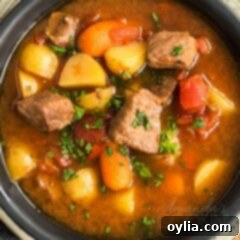
Dutch Oven Goulash
IMPORTANT – There are often Frequently Asked Questions within the blog post that you may find helpful. Simply scroll back up to read them!
Print It
Rate It
Save ItSaved!
Ingredients
- 2 pounds beef chuck roast cut into 1-inch cubes (or stew meat)
- ¼ cup sweet paprika
- 1 teaspoon caraway seeds
- 2 teaspoons dried marjoram
- 2 teaspoon Kosher salt
- ½ teaspoon freshly ground black pepper
- 1 heaping tablespoon all purpose flour
- 3 tablespoons olive oil
- 1 cup chopped yellow onion
- 1 teaspoon minced garlic about two cloves
- 14 ounce can fire roasted diced tomatoes undrained
- 5 cups beef broth
- 2 tablespoons Worcestershire sauce
- 8 ounces baby carrots about 1 1/2 cups
- 1 pound quartered baby Yukon Gold potatoes about 3 cups
- 4 ounces chopped sweet peppers about 1 cup
Things You’ll Need
-
5 qt Dutch oven
-
Ladle
-
Wooden spoon
-
Serving bowls
Before You Begin
Instructions
-
Combine paprika, caraway seeds, marjoram, Kosher salt, black pepper and flour in a large plastic zipper bag. Place cubed meat into the bag and close, then shake to coat.
-
In Dutch oven over medium heat sauté chopped onion in olive oil until tender, about 3-4 minutes. Add garlic and sauté another 30 seconds.
-
Add entire contents of meat shaking bag to the onion mixture in the pan. Cook, turning occasionally until meat is browned well.
-
Add beef broth, Worcestershire sauce and canned tomatoes (including its juices) and stir. Bring to a boil then reduce heat to low and simmer uncovered for one hour.
-
Add the baby carrots and potatoes and stir. Cover and cook on low for one hour.
-
Add chopped sweet peppers and stir. Cover and cook another 30 minutes or until meat and vegetables are fork tender.
Nutrition
The recipes on this blog are tested with a conventional gas oven and gas stovetop. It’s important to note that some ovens, especially as they age, can cook and bake inconsistently. Using an inexpensive oven thermometer can assure you that your oven is truly heating to the proper temperature. If you use a toaster oven or countertop oven, please keep in mind that they may not distribute heat the same as a conventional full sized oven and you may need to adjust your cooking/baking times. In the case of recipes made with a pressure cooker, air fryer, slow cooker, or other appliance, a link to the appliances we use is listed within each respective recipe. For baking recipes where measurements are given by weight, please note that results may not be the same if cups are used instead, and we can’t guarantee success with that method.
This post originally appeared here on Oct 28, 2015, and has been updated for clarity, detail, and SEO optimization.
